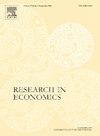From globalization to glocalization: Cultural interdependence as a source of FDI motivation
IF 1.2
Q3 ECONOMICS
引用次数: 0
Abstract
In this paper, we explore the agglomeration effect of culture on foreign direct investment (FDI). Using data on US FDI to 74 host countries from 1984 to 2017, our analysis shows a negative effect of bilateral cultural distance on US FDI to a host, consistent with previous studies. Central to our research is the application of a higher-order spatial model, which enables us to examine correlations of FDI across various hosts along both geographical and cultural dimensions. We find that US FDI across culturally similar host nations move together. Specifically, our results show that US FDI in a host may rise by 0.25% with every 1% increase in US FDI in other hosts that are culturally similar to the host of interest. Such results are robust to a battery of sensitivity checks, such as controlling for spatial correlation of geographically proximate hosts. Further, the agglomeration effects also display significant variations across industries.
求助全文
约1分钟内获得全文
求助全文
来源期刊

Research in Economics
ECONOMICS-
CiteScore
1.40
自引率
0.00%
发文量
37
审稿时长
89 days
期刊介绍:
Established in 1947, Research in Economics is one of the oldest general-interest economics journals in the world and the main one among those based in Italy. The purpose of the journal is to select original theoretical and empirical articles that will have high impact on the debate in the social sciences; since 1947, it has published important research contributions on a wide range of topics. A summary of our editorial policy is this: the editors make a preliminary assessment of whether the results of a paper, if correct, are worth publishing. If so one of the associate editors reviews the paper: from the reviewer we expect to learn if the paper is understandable and coherent and - within reasonable bounds - the results are correct. We believe that long lags in publication and multiple demands for revision simply slow scientific progress. Our goal is to provide you a definitive answer within one month of submission. We give the editors one week to judge the overall contribution and if acceptable send your paper to an associate editor. We expect the associate editor to provide a more detailed evaluation within three weeks so that the editors can make a final decision before the month expires. In the (rare) case of a revision we allow four months and in the case of conditional acceptance we allow two months to submit the final version. In both cases we expect a cover letter explaining how you met the requirements. For conditional acceptance the editors will verify that the requirements were met. In the case of revision the original associate editor will do so. If the revision cannot be at least conditionally accepted it is rejected: there is no second revision.
 求助内容:
求助内容: 应助结果提醒方式:
应助结果提醒方式:


